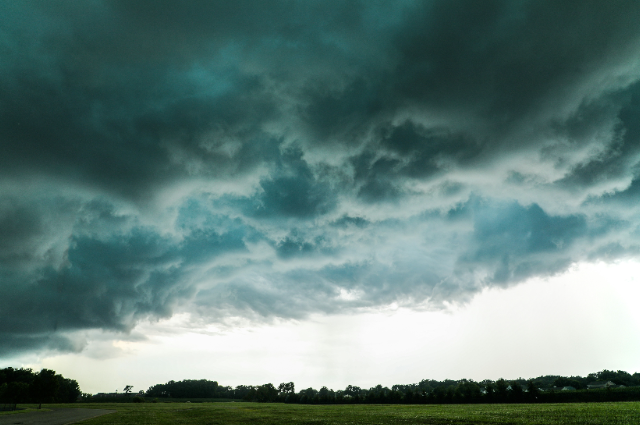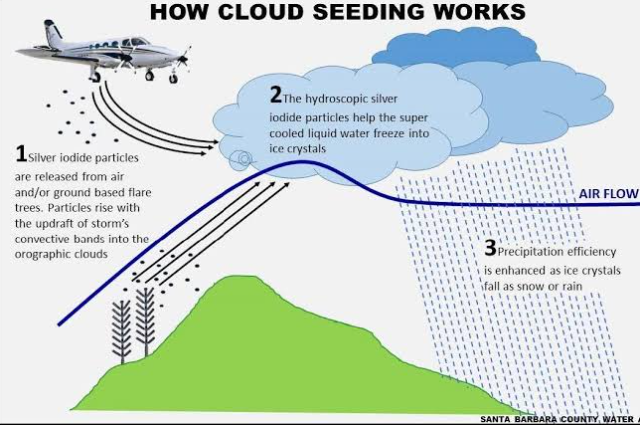
Photo by Michael & Diane Weidner on Unsplash
Introduction:
In response to shortage in water resources, exacerbated by growing populations and a changing climate, an increasing number of countries have invested in weather modification, research and applications. Precipitation enhancement is a subset of weather modification that aims to augment natural rainfall (or snowfall) amounts through airborne or ground-based interventions in the microphysical processes of specific cloud types.
Cloud seeding is a type of weather modification that aims to change the amount or type of precipitation, mitigate hail or disperse fog. The usual objective is to increase rain or snow. Cloud seeding is undertaken by dispersing substances into the air that serve as cloud condensation or ice nuclei. Common agents include silver iodide, potassium iodide, and dry ice, with hygroscopic materials like table salt gaining popularity due to their ability to attract moisture. Techniques vary from static seeding, which encourages ice particle formation in supercooled clouds to increase precipitation, to dynamic seeding designed to enhance convective cloud development through the release of latent heat. Targeting warm clouds, hygroscopic cloud seeding entails introducing large artificial (hygroscopic) aerosol particles into clouds to increase the uptake of available cloud liquid water beyond that expected from the natural background aerosol population with relatively smaller diameter (4-6). The larger seeding particles are expected to trigger a "competition effect" which favors the production of large drops that can activate that collision-coalescence process to enhance rainfall generation.
The basic assumption is that increased cloud buoyancy, achieved through conversion of cloud water content into liquid droplets through condensation, will enhance the release of latent heat, increase cloud depth and result in larger cloud extent and lifetime and also rainfall intensity.
According to the most recent review on global precipitation enhancement activities conducted by the WORLD METEOROLOGICAL ORGANIZATION (WMO) expert team on weather modification, cloud seeding from aircraft platforms is generally considered more effective compared to other techniques such as ground-based generators, customized rockets and artillery shells. Results from operational cloud seeding programs spanning several countries including, Australia, China, India, Israel, South-Africa, Thailand, and the United States record between 10-30% increment in precipitation amounts and cloud lifetime. Alternatively, several studies report on the limited efficacy of seeding experiments for drought relief.
Located on the eastern Arabian Peninsula, the United Arab Emirates (UAE) features a hyper arid climate. Its annual rainfall varies from 30mm in the inland desert to 120mm in the Al Hajar Mountains in the eastern and north-eastern parts of the country. The vast majority of the precipitation falls from November to March with a substantial interannual variability and a long-term decline seen throughout the region. Although less frequent, summertime rainfall can be significant, with localized accumulations in excess of 100 mm.
As an attempt to mitigate the arid conditions and ongoing drying tendency, which may intensify with global warming, precipitation enhancement activities such as cloud seeding, have been increasingly performed in the UAE. Seeding is mostly conducted on the eastern half of the country, where summertime convection is more frequent and cloud seeding aids in the recharge of the under-ground aquifers.
Climate Needs:
The UAE has an arid climate with less than 100mm per year of rainfall, a high evaporation rate of surface water and a low groundwater recharge rate. Rainfall in UAE has been fluctuating over the last few decades in winter season between December and March. The climate of UAE is a very dry region aside from the coast and the border of the UAE and Oman, where there is high humidity.
Due to industrialization and population growth, the demand for water has rapidly increased. Current resources are being depleted and scarcity issues are arising. Consequently, the UAE is looking to cloud seeding technologies to increase water security as well as renewability to combat water and food scarcity that may arise.
Methods and Techniques:
- SALT: - The most common chemicals used for cloud seeding include silver iodide, potassium iodide and dry ice (solid carbon dioxide). Liquid propane, which expands into a gas, has also been used. It can produce ice crystals at higher temperatures than silver iodide. After promising research, the use of hygroscopic materials, such as table salt, is becoming more popular. When cloud seeding increased, snowfall takes place when temperatures within the clouds are between -20 and -7 degree Celsius. Freezing nucleation is induced by the introduction of substances similar to silver iodide which has a crystalline structure like ice.
- ELECTRIC CHARGES: - Since 2021, the United Arab Emirates have been using drones equipped with a payload of electric-charge emission instruments and customized sensors that fly at low altitudes and deliver an electric charge to air molecules. This method produced a significant rainstorm in July 2021.
- INFRARED LASER PULSES: - An electronic mechanism was tested in 2010, when infrared laser pulses were directed to the air above Berlin by researchers from the University of Geneva. The experimenters posited that the pulses would encourage atmospheric sulfur dioxide and nitrogen dioxide to form particles that would then act as seeds.
Advantages of Cloud Seeding:
- CREATES RAIN: - When rain is badly needed, cloud seeding is perhaps the only way to produce rain. Rain is important for keeping the area hydrated and fertile for growing crops and other plants.
- BOOSTS ECONOMY: - When there is rain, there is farm produce. Farms that yield better can help the local economy and feed the people and even animals. Cloud seeding can greatly improve the living conditions in dry and arid places.
- REGULATES WEATHER: - Cloud seeding in a way, gives us the ability to control the weather condition in a particular area. It does not just make rain; it also regulates water vapor that in turn prevents damages brought by destructive hails and storms.
- MAKES DRY PLACES MORE LIVABLE: - Local people have an impressive way of adapting to their natural environment. But inhospitable places rarely visited by rain can be inhospitable to tourists and foreigners. Cloud seeding can make such places livable.
Disadvantages of Cloud Seeding:
- REQUIRES POTENTIALLY HARMFUL CHEMICALS: - Chemicals used in cloud seeding can potentially damage the environment, especially the plants. Silver iodide may cause "iodism" a type of iodine poisoning where the patient exhibits running nose, headache, skin rashes, anemia, and diarrhea. Also found to be highly toxic to aquatic life, livestock and humans.
- IS NOT A FULL PROOF: - Cloud seeding requires rain clouds. It cannot work on just any other cloud formation. Also, seeded clouds may actually travel to another located and do not cause precipitation on the intended location.
- FLOODING: - It is predicted that climate change will lead to high temperatures, increased humidity and a greater risk of flooding in parts of the Gulf region. These issues could be worsened in nations like the UAE which do not have adequate drainage infrastructure to manage heavy rainfall. Cloud seeding activities conducted in 2019 by the UAE, National Center of Meteorology (NCM) as a part of the UAE Research Program for Rain Enhancement Science were carried out prior to floods in Dubai in 2019. Experts are doubtful that cloud seeding played a major role in the UAE's April 2024 floods, suggesting that the heavy rainfall likely caused by the anthropogenic climate change. SHARJAH, one of the most populous cities in the UAE, has experienced repetitive urban flooding during the rainy season over the last three decades.
- ATMOSPHERIC AERSOLS: - Cloud seeding missions require firing salts and silver iodide crystals into the atmosphere. The increased concentration of particulate matter, or micro-pollutants, increases risk for respiratory illnesses. In 2017, a study was conducted before and after cloud seeding missions, which recorded an increase of particulate matter, correlating to the months of active artificial rain. Researchers attributed this to left over silver iodide crystals that were not dispersed in rain during cloud seeding months. A study was conducted called the UAE Unified Aerosol Experiment (UAE) to assess the progress and effectiveness of cloud seeding specifically in the UAE.
- COSTS A LOT: - It is very expensive to produce artificial rain. The chemicals have to be delivered to the air via planes which are hard to come by in places with very minimal income.
CONCLUSION:
Even if cloud seeding does succeed at increasing precipitation, environmental activities are concerned about its impact. One scientist addressing those concerns is Geochemist, SHAWN BENNER at Boise State University. "The near impossibility of detecting a silver iodide signal in snowpack after seeding attests to its low environmental risk", Benner says.
Nevertheless, if the practice of cloud seeding intensifies at a larger scale, silver toxicity and other environmental issues could become a concern. Aside from silver toxicity, some cloud-seeding critics raise concerns about messing with the balance that Mother Nature holds on to the atmosphere. The amount of moisture in the atmosphere is determined by the balance between evaporation and precipitation. Atmospheric budgets suggests that cloud seeding is unlikely to steal moisture from downwind sites, responds weather modification's Boe. Because clouds represent a modest portion of the moisture in the atmosphere, a cloud-seeding effect of 15% would only remove about 1-2% of the total water vapor in the seeding area.
But at present, making rain is still more of an art than science. With countries increasingly spending hundreds of millions of dollars on weather modification, more research is needed to understand if the practice works and what its environmental, social and governance impacts will be.

